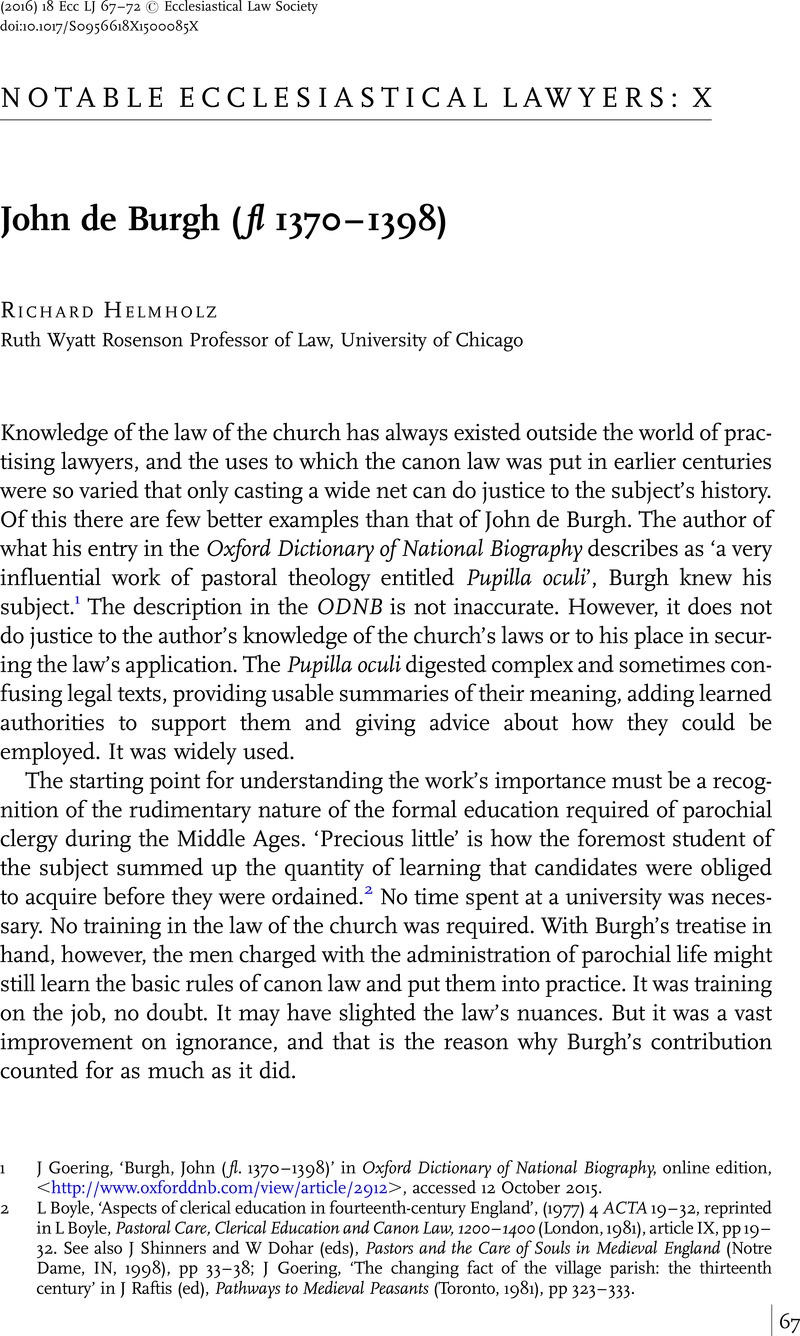Published online by Cambridge University Press: 10 December 2015

1 J Goering, ‘Burgh, John (fl. 1370–1398)’ in Oxford Dictionary of National Biography, online edition, <http://www.oxforddnb.com/view/article/2912>, accessed 12 October 2015.
2 Boyle, L, ‘Aspects of clerical education in fourteenth-century England’, (1977) 4 ACTA 19–32Google Scholar, reprinted in L Boyle, Pastoral Care, Clerical Education and Canon Law, 1200–1400 (London, 1981), article IX, pp 19–32. See also J Shinners and W Dohar (eds), Pastors and the Care of Souls in Medieval England (Notre Dame, IN, 1998), pp 33–38; J Goering, ‘The changing fact of the village parish: the thirteenth century’ in J Raftis (ed), Pathways to Medieval Peasants (Toronto, 1981), pp 323–333.
3 See Goering, ‘Burgh, John’.
4 A Emden, Biographical Register of the University of Cambridge to 1500 (Cambridge, 1963), p 107.
5 J Mullinger, The University of Cambridge from The Earliest Times to the Royal Injunctions of 1535 (Cambridge, 1911, reprinted 1969), pp 140–143; D Leader, History of the University of Cambridge, Vol 1: the university to 1546 (Cambridge, 1988), pp 200–201.
6 See entry in ‘Notes on Cambridge clerks petitioning for benefices, 1370–1399’, (1943–1945) 20 Bulletin of the Institute of Historical Research 75–96 at 83.
7 An instructive essay is J Goering, ‘Leonard E. Boyle and the invention of pastoralia’ in R Stansbury (ed), Companion to Pastoral Care in the late Middle Ages (1200–1500) (Leiden and Boston, MA, 2010), pp 7–20.
8 Examples, with discussion, are found in A Van Hove, Prolegomena ad codicem iuris canonici (Mechelen and Rome, 1945), pp 512–517.
9 The most recent and complete treatment related to Burgh is H Kelly, ‘Penitential theology and law at the turn of the fifteenth century’, in A Firey (ed), A New History of Penance (Leiden and Boston, MA, 2008), pp 239–317.
10 See eg S Wenzel (ed and trans), Fasciculus Morum: a fourteenth-century preacher's handbook (University Park, PA, 1989).
11 See L Boyle, ‘The Oculus sacerdotis and some other works of William of Pagula’, (1955) 5th series 5 Transactions of the Royal Historical Society 81–110, reprinted in Boyle, Pastoral Care, article IV. See also J Baker, ‘William Paull’ in Monuments of Endlesse Labours: English Canonists and their Work 1300–1900 (London and Rio Grande, OH, 1998), pp 9–15.
12 For Boyle's views, see Boyle, ‘Oculus sacerdotis’, pp 84–87. His opinion was also shared by Cardinal Gasquet: see F Gasquet, Old English Bible and Other Essays (London, 1897), pp 195–198.
13 See Davis, H, ‘The canon law in England’, (1914) 34 Zeitschrift der Savigny-Stiftung für Rechtsgeschichte, Kanonistische Abteilung 344–363Google Scholar at 349–350; W Pantin, The English Church in the Fourteenth Century (Notre Dame, IN, 1962), pp 213–214; J Hughes, Pastors and Visionaries: religion and secular life in late medieval Yorkshire (Woodbridge, 1998), pp 193–194; Kelly, ‘Penitential theology’, pp 243–244.
14 K Harris, ‘The patronage and dating of Longleat House MS 24, a prestige copy of the Pupilla oculi illuminated by the master of the Troilus frontispiece’ in F Riddy (ed), Prestige, Authority and Power in Late-medieval Manuscripts and Texts' (York, 2000), pp 35–54.
15 The entry in the ODNB states that it was printed at least four times before 1500, but I think that this must be a slip. See eg British Museum General Catalogue of Printed Books, vol 30 (London 1955), p 98, listing editions published in 1510, 1514, 1516, 1518 and 1521; the last edition to which I have seen a reference was published in London in 1590.
16 Eg J de Burgh, Pupilla oculi, pt VIII, ch 15, lit B (citation of Dig 25.4.1).
17 For example, part VI contains only 2 chapters, whereas part VIII has 18.
18 F Pollock and F Maitland, History of English Law (second edition reissued, Cambridge, 1968), vol 2, p 368.
19 Burgh, Pupilla oculi, pt VIII, ch 2, lit L: ‘Si autem secrete contracta fuerint sine iudicio ecclesie dissolvi possunt secundum Richardum super iiii, dist. xxvii’.
20 Ibid, pt V, ch 22, is devoted to it.
21 Eg D Wilkins, Concilia Magnae Britanniae et Hiberniae (London, 1737), vol 2, pp 240–242: ‘Sententia excommunicationis per Robertum Cantuariensem archiepiscopum lata contra … infringentes articulos chartarum, scilicet Magnae Cartae’ (1298); see also D Carpenter, Magna Carta (London, 2015), pp 422–423.
22 C Cheney, ‘The Church and Magna Carta’, (1965) 65 Theology 265–272 at 272.
23 Leader, History of the University of Cambridge, p 199.
24 He is mentioned only in H Hurter, Nomenclator literarius theologiae catholicae theologos (Innsbruck, 1903–1913), vol 2, pp 714–715.